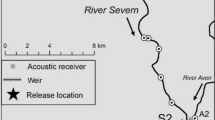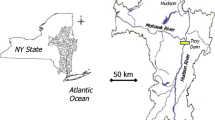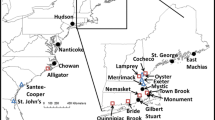Abstract
We described and predicted spatial variation in marine migration (anadromy) of female Oncorhynchus mykiss in the John Day River watershed, Oregon. We collected 149 juvenile O. mykiss across 72 sites and identified locations used by anadromous females by assigning maternal origin (anadromous versus non-anadromous) to each juvenile. These assignments used comparisons of strontium to calcium ratios in otolith primordia and freshwater growth regions to indicate maternal origin. We used logistic regression to predict probability of anadromy in relation to mean annual stream runoff using data from a subset of individuals. This model correctly predicted anadromy in a second sample of individuals with a moderate level of accuracy (e.g., 68% correctly predicted with a 0.5 classification threshold). Residuals from the models were not spatially autocorrelated, suggesting that remaining variability in the expression of anadromy was due to localized influences, as opposed to broad-scale gradients unrelated to mean annual stream runoff. These results are important for the management of O. mykiss because anadromous individuals (steelhead) within the John Day River watershed are listed as a threatened species, and it is difficult to discern juvenile steelhead from non-anadromous individuals (rainbow trout) in the field. Our results provide a broad-scale description and prediction of locations supporting anadromy, and new insight for habitat restoration, monitoring, and research to better manage and understand the expression of anadromy in O. mykiss.


Similar content being viewed by others
Notes
Use of trade or firm names is for reader information only and does not constitute endorsement of any product or service by the U.S. Government
References
Anonymous (2005) National Hydrography Dataset Plus—NHDPlus [computer file]. U.S. Environmental Protection Agency and the U.S. Geological Survey
Anonymous (2006a) United States average monthly or annual precipitation, 1971–2000 [computer file]. The PRISM Group at Oregon State University, Corvallis
Anonymous (2006b) United States average monthly or annual maximum temperature, 1971–2000 [computer file]. The PRISM Group at Oregon State University, Corvallis
Aubin-Horth N, Bourque J-F, Daigle G, Hedger R, Dodson JJ (2006) Longitudinal gradients in threshold sizes for alternative male life history tactics in a population of Atlantic salmon (Salmo salar). Can J Fish Aquat Sci 63:2067–2075
Barry JJ, Buffington JM, King JG (2004) A general power equation for predicting bed load transport rates in gravel bed rivers. Water Resour Res 40:W10401
Beard TD, Carline RF (1991) Influence of spawning and other stream habitat features on spatial variability of wild brown trout. Trans Am Fish Soc 120:711–722
Beland KF (1996) The relation between redd counts and Atlantic salmon (Salmo salar) parr populations in the Dennys River, Maine. Can J Fish Aquat Sci 53:513–519
Boyce MS (2006) Scale for resource selection functions. Diversity and Distributions 12:269–276
Busby PJ, Wainwright TC, Bryant GJ, Lierheimer LJ, Waples RS, Waknitz FW and Lagomarsino IV (1996). Status review of West Coast steelhead from Washington, Idaho, Oregon, and CaliforniaNOAA Tech. Memo. NMFS-NWFSC-27. United States Department of Commerce, p 275
Chernoff E, Curry RA (2007) First summer growth predetermined in anadromous and resident brook charr. J Fish Biol 70:334–346
de Villiers S (1999) Seawater strontium and Sr/Ca variability in the Atlantic and Pacific oceans. Earth Planet Sci Lett 171:623–634
Donohoe CJ, Zimmerman CE (2010) A method of mounting multiple otoliths for beam-based microchemical analyses. Environ Biol Fishes 89:473–477
Donohoe CJ, Adams PB, Royer CF (2008) Influence of water chemistry and migratory distance on ability to distinguish progeny of sympatric resident and anadromous rainbow trout (Oncorhynchus mykiss). Can J Fish Aquat Sci 65:1060–1075
Freeman EA, Moisen GG (2008) A comparison of the performance of threshold criteria for binary classification in terms of predicted prevalence and kappa. Ecol Model 217:48–58
Gönen M (2007) Analyzing reciever operating characteristic curves with SAS. SAS, Cary
Hartl DL, Clark AG (2007) Principles of population genetics, 4th edn. Sinauer, Sunderland
Hendry AP, Bohlin T, Jonsson B, Berg OK (2004) To sea or not to sea? Anadromy versus non-anadromy in salmonids. In: Hendry AP, Stearns SC (eds) Evolution illuminated: salmon and their relatives. Oxford University Press, Inc., New York, pp 92–125
Hosmer DW, Lemeshow S (2000) Applied logistic regression. Wiley, New York
Johnson CJ, Nielsen SE, Merrill EH, McDonald TL, Boyce MS (2006) Resource selection functions based on use-availibility data: theoretical motivation and evaluation methods. J Wildl Manag 70:347–357
Jonsson B, Jonsson N (1993) Partial migration: niche shift versus sexual maturation in fishes. Rev Fish Biol Fish 3:348–365
Kahler TH, Roni P, Quinn TP (2001) Summer movement and growth of juvenile anadromous salmonids in small western Washington streams. Can J Fish Aquat Sci 58:1947–1956
Kalish JM (1990) Use of otolith microchemistry to distinguish the progeny of sympatric anadromous and non-anadromous salmonids. Fish Bull 88:657–666
Kalish JM, Beamish RJ, Brothers EB, Casselman JM, Francis, H. Mosegaard RICC, Panfili J, Prince ED, Thresher RE, Wilson CA, Wright PJ (1995) Glossary for otolith studies. In Recent developments in fish otolith research. In: Secor DH, Dean JM, Campana SE, Belle W (eds) Baruch Libr. Mar. Sci. No. 19, pp 723–729
Koizumi I, Yamamoto S, Maekawa K (2006) Female-biased migration of stream-dwelling Dolly Varden in the Shiisorapuchi River, Hokkaido, Japan. J Fish Biol 68:1513–1529
Legendre P (1993) Spatial autocorrelation: trouble or new paradigm? Ecology 74:1659–1673
Lloyd J, Bowers J (2002) Limited Oregon resident trout habitat distribution (Rainbow, Redband, Brook, and Hybridized Rainbow and Cutthroat Trout) [computer file]. Oregon Department of Fish and Wildlife, Portland
Lloyd J, Bowers J (2004) Oregon salmon and steelhead habitat distribution (1:100,000) [computer file]. Oregon Department of Fish and Wildlife, Portland
Manel S, Williams HC, Ormerod SJ (2001) Evaluating presence-absence models in ecology: the need to account for prevalence. J Appl Ecol 38:921–931
McMillan JR, Katz SL, Pess GR (2007) Observational evidence of spatial and temporal structure in a sympatric anadromous (Winter Steelhead) and resident rainbow trout mating system on the Olympic Peninsula, Washington. Trans Am Fish Soc 136:736–748
McMillan JR, Dunham JB, Reeves GH, Mills JS, Jordan CE (2011). Individual condition and stream temperature influence early maturation of rainbow and steelhead trout, Oncorhynchus mykiss. Env Biol Fish. doi:10.1007/s10641-011-9921-0
Miao SL, Carstenn S, Nungesser M (eds) (2009) Real-world ecology: large-scale and long-term case studies and methods. Springer, New York
Montgomery DR, Beamer EM, Pess GR, Quinn TP (1999) Channel type and salmonid spawning distribution and abundance. Can J Fish Aquat Sci 56:377–387
Narum SR, Hatch D, Talbot AJ, Moran P, Powell MS (2008) Iteroparity in complex mating systems of steelhead Oncorhynchus mykiss (Walbaum). J Fish Biol 72:45–60
Nelson JS, Crossman EJ, Espinosa-Pérez H, Findley LT, Gilbert CR, Lea RN, Williams JD (2004) Common and scientific names of fishes from the United States, Canada and Mexico. Special Publication 29, American Fisheries Society, Bethesda, Maryland
Neville HM, Isaak DJ, Dunham JB, Thurow RF, Rieman BE (2006) Fine-scale natal homing and localized movement as shaped by sex and spawning habitat in Chinook salmon: insights from spatial autocorrelation analysis of individual genotypes. Mol Ecol 15:4589–4602
Northcote TG (1997) Potamodromy in Salmonidae: living and moving in the fast lane. North American Journal of Fisheries Management 17:1029–1045
Olsson IC, Greenberg LA (2004) Partial migration in a landlocked brown trout population. J Fish Biol 65:106–121
Olsson IC, Greenberg LA, Bergman E, Wysujack K (2006) Environmentally induced migration: the importance of food. Ecol Lett 9:645–651
Pollard WR, Hartman GF, Groot C, Edgell P (1997) Field identification of coastal juvenile salmonids. Harbour, Madeira Park
Power ME (1984) Depth distributions of armored catfish: predator-induced resource avoidance? Ecology 65:523–528
Quinn TP, Kinnison MT (1999) Size-selective and sex-selective predation by brown bears on sockeye salmon. Oecologia 121:273–282
Reeves GH, Benda LE, Burnett KM, Bisson PA, Sedell JR (1995) A disturbance-based ecosystem approach to maintaining and restoring freshwater habitats of evolutionarily significant units of anadromous salmonids in the Pacific Northwest. Am Fish Soc Symp 17:334–349
Reice S, Wissmar R, Naiman R (1990) Disturbance regimes, resilience, and recovery of animal communities and habitats in lotic ecosystems. Environ Manage 14:647–659
Rieman BE, Myers DL, Nielsen RL (1994) Use of otolith microchemistry to discriminate Oncorhynchus nerka of resident and anadromous origin. Can J Fish Aquat Sci 51:68–77
Rosenberg MS (2005) PASSaGE. Pattern analysis, spatial statistics and geographic exegesis. Version 1.1.3.4. Department of Biology, Arizona State University, Tempe
Sanborn SC, Bledsoe BP (2006) Predicting streamflow regime metrics for ungauged streams in Colorado, Washington, and Oregon. J Hydrol 325:241–261
Stevens DL, Olsen AR (2004) Spatially balanced sampling of natural resources. J Am Stat Assoc 99:262–278
Tattam IA (2006) Seasonal life history of Oncorhynchus mykiss in the South Fork John Day River. Oregon State University, Corvallis, OR, p 145
Thériault V, Dodson JJ (2003) Body size and the adoption of a migratory tactic in brook charr. J Fish Biol 63:1144–1159
Thériault V, Garant D, Bernatchez L, Dodson JJ (2007) Heritability of life-history tactics and genetic correlation with body size in a natural population of brook charr (Salvelinus fontinalis). J Evol Biol 20:2266–2277
Thorpe JE, Metcalfe NB (1998) Is smolting a positive or a negative developmental decision? Aquaculture 168:95–103
Torgersen CE, Price DM, Li HW, McIntosh BA (1999) Multiscale thermal refugia and stream habitat associations of Chinook salmon in northeastern Oregon. Ecol Appl 9:301–319
Torgersen CE, Baxter CV, Li HW, McIntosh BA (2006) Landscape influences on longitudinal patterns of river fishes: spatially continuous analysis of fish–habitat relationships. Am Fish Soc Symp 48:473–492
Vannote RL, Minshall GW, Cummins KW, Sedell JR, Cushing CE (1980) The river continuum concept. Can J Fish Aquat Sci 37:130–137
Volk EC (1999) Otolith strontium:calcium ratios in four populations of anadromous and resident Oncorhynchus mykiss from Eastern Oregon. Washington Department of Fish and Wildlife. Otolith Laboratory, Olympia
Wells BK, Rieman BE, Clayton JL, Horan DL, Jones CM (2003) Relationships between water, otolith, and scale chemistries of Westslope cutthroat rout from the Coeur d'Alene River, Idaho: the potential application of hard-part chemistry to describe movements in freshwater. Trans Am Fish Soc 132:409–424
Wysujack K, Greenberg LA, Bergman E, Olsson IC (2009) The role of the environment in partial migration: food availability affects the adoption of a migratory tactic in brown trout Salmo trutta. Ecol Freshw Fish 18:52–59
Zimmerman CE (2005) Relationship of otolith strontium-to-calcium ratios and salinity: experimental validation for juvenile salmonids. Can J Fish Aquat Sci 62:88–97
Zimmerman CE, Reeves GH (2000) Population structure of sympatric anadromous and nonanadromous Oncorhynchus mykiss: evidence from spawning surveys and otolith microchemistry. Can J Fish Aquat Sci 57:2152–2162
Zimmerman CE, Reeves GH (2002) Identification of steelhead and resident rainbow trout progeny in the Deschutes River, Oregon, revealed with otolith microchemistry. Trans Am Fish Soc 131:986–993
Acknowledgements
All sampling was conducted in accordance with the Oregon Department of Fish and Wildlife permit # OR2007-3680 M1, which was approved by NOAA and USFWS under the Endangered Species Act. Several biologists at the ODFW, including Tim Unterwegner, Jim Ruzycki, Jeff Neal, Shelly Miller, and Chris James, helped identify survey locations and provided critical information on the biology of O. mykiss in the John Day River basin. Peter Stratis, Nick Smith, and Brett Blundon provided assistance in the field and laboratory. Bob Hoffman, Cam Jones, Kathy Motter, and Frank Tepley provided assistance with analyses of water quality and otolith microchemistry. We thank three anonymous reviewers and J. Falke and K. McNyset for constructive comments on an early draft. Funding was provided by NOAA, USGS, and the USFS. Use of trade or firm names is for reader information only and does not constitute endorsement of any product or service by the U.S. Government.
Author information
Authors and Affiliations
Corresponding author
Rights and permissions
About this article
Cite this article
Mills, J.S., Dunham, J.B., Reeves, G.H. et al. Variability in expression of anadromy by female Oncorhynchus mykiss within a river network. Environ Biol Fish 93, 505–517 (2012). https://doi.org/10.1007/s10641-011-9946-4
Received:
Accepted:
Published:
Issue Date:
DOI: https://doi.org/10.1007/s10641-011-9946-4




